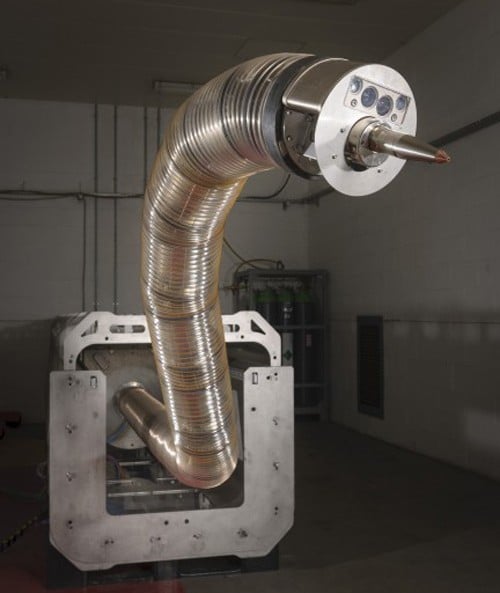This Laser-Toting Tentacle Carves Up Old Nuclear Hardware

Say hello to the Laser Snake.
As well as looking like something from a nightmare, according to its makers it’s also the world’s first device to be used to remotely laser-cut equipment inside a nuclear power facility.
Developed by the U.K.-based company OC Robotics, the machine uses a series of wire ropes that run along the length of its arm to articulate its joints. Carefully adjusting tension in each of the cables enables it to twist itself through tight spaces and negotiate awkward geometries.
The robotic arm itself is actually hollow, which allows OC Robotics to install tools at its end—in this case, for laser cutting. The arm currently holds a five-kilowatt laser, which is able to cut through thick plates of steel in both air and water.
Its most recent test took place in the Sellafield nuclear power plant, in the north of England, which is currently being decommissioned. There, it was used to slice up a thick dissolver vessel, which had previously formed part of the core nuclear reactor hardware.

It’s by no means the first robot designed to work in hostile environments. The Atlas robot, made by Boston Dynamics, was designed as a humanoid machine that could carry out tasks in dangerous locations. Toshiba even built a submersible robot designed specifically to help repair the Fukushima nuclear power plant.
These kinds of robots all serve to remove humans from undue risk. And, in the case of Laser Snake, perhaps even keep you awake at night.
(Read more: OC Robotics, “Agile Robots,” “The Underwater Robot That Will Repair Fukushima”)
Keep Reading
Most Popular
Large language models can do jaw-dropping things. But nobody knows exactly why.
And that's a problem. Figuring it out is one of the biggest scientific puzzles of our time and a crucial step towards controlling more powerful future models.
The problem with plug-in hybrids? Their drivers.
Plug-in hybrids are often sold as a transition to EVs, but new data from Europe shows we’re still underestimating the emissions they produce.
Google DeepMind’s new generative model makes Super Mario–like games from scratch
Genie learns how to control games by watching hours and hours of video. It could help train next-gen robots too.
How scientists traced a mysterious covid case back to six toilets
When wastewater surveillance turns into a hunt for a single infected individual, the ethics get tricky.
Stay connected
Get the latest updates from
MIT Technology Review
Discover special offers, top stories, upcoming events, and more.